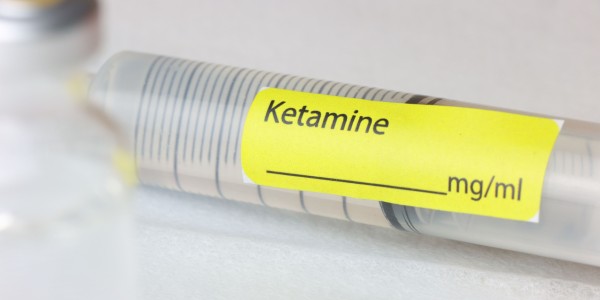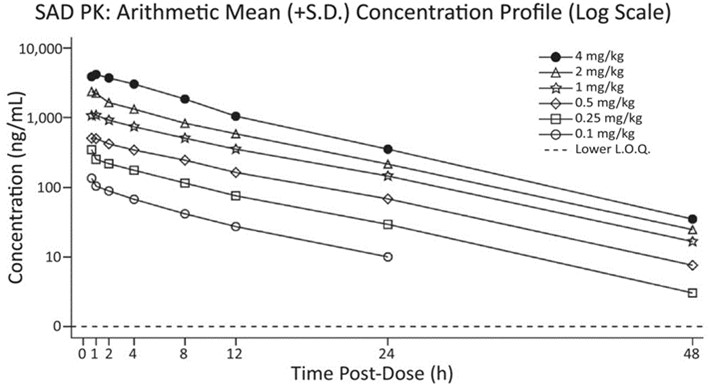New Hope for Rapid-Acting Depression Treatment
• Research Highlight
Depression symptoms can be hard to manage, especially for people with treatment-resistant depression, a persistent and severe form of the disorder. Fortunately, new therapies are emerging for such hard-to-treat conditions. One of these is the medication ketamine, which numerous NIMH-funded studies have shown has fact-acting and lasting effects in people with mood disorders like depression.

The discovery of ketamine has been a game changer for people with severe depression, who often need rapid relief from life-threatening symptoms. Whereas most antidepressants take weeks or months to work, ketamine works within hours to strongly reduce depression symptoms in people for whom other treatments have not worked.
Despite ketamine’s effectiveness as an antidepressant, serious concerns limit its use, including problematic side effects and a high risk of misuse. To address these concerns, the National Institutes of Health (NIH) is invested in finding medications that capitalize on the therapeutic effects of ketamine while avoiding its negative ones.
What did the researchers look at in the study?
New research funded through the NIH Blueprint Neurotherapeutics Network for Small Molecules program examined a novel ketamine-related medication known as RR-HNK. RR-HNK is a metabolite , or byproduct, of ketamine left over as the body breaks it down. RR-HNK showed antidepressant effects in preclinical studies with animals , but it had not yet been tested in humans.
The study involved a broad collaboration of researchers in the intramural programs at NIH’s National Institute of Mental Health, National Center for Advancing Translational Sciences, and National Institute on Aging; the Duke University and the University of Maryland School of Medicine; and other national and international institutions.
What did the researchers do in the study?
This study examined the safety, tolerability, pharmacokinetics (how the drug moves through the body), and pharmacodynamics (how the drug affects the body) of RR-HNK for the first time in humans.
Participants were healthy adults between 18–65 years. A total of 74 people participated across three randomized trials: 55 received RR-HNK and 19 received an inactive placebo. Both the medication and placebo were given intravenously, with participants and researchers unaware of which group the participants were in.
- In Trial 1, participants received one of six dose levels of RR-HNK a single time.
- In Trial 2, participants received one of two dose levels of RR-HNK four times over 2 weeks.
- In Trial 3, participants received a single dose of RR-HNK, and their cerebrospinal fluid (a liquid surrounding the brain and spinal cord) was collected.
The study's primary aim was to determine if the medication is safe by first testing it in healthy adults without a diagnosed mental health condition. Throughout the study, the researchers closely monitored for adverse events, such as negative side effects. The comprehensive safety profile included physical examinations; laboratory results; vital signs; electrocardiograms of heart activity; and ratings of mood, suicide risk, and dissociation and sedation symptoms. Additionally, participants were asked to tell study staff if they experienced any concerns or side effects at any point.
The researchers also collected blood and urine samples from all participants before, during, and after receiving the medication. These samples and the cerebrospinal fluid collected in Trial 3 were used to check whether the medication entered the body and the brain.
As a final exploratory step, the researchers used brain imaging to examine participants’ gamma oscillations (a type of brain wave) before and after the medication. This measure of the brain’s response to stimuli is one of the few available biomarkers of a medication’s effects on the brain.
What did the study find?
RR-HNK revealed itself to be exceptionally safe, causing no serious adverse events and only mild side effects that resolved quickly without care. Participants also reported no symptoms of sedation or dissociation. The positive safety profile was maintained at all doses tested and after multiple doses. Together, the results indicate that RR-HNK is safe and tolerable, with limited abuse or misuse potential.
Cerebrospinal fluid confirmed that RR-HNK entered the brain and remained at detectable levels several hours after administration. Results further showed a dose-proportional response to the medication, meaning that at higher levels of RR-HNK, the amount of the substance in the body also increased at the same rate. A predictable relationship between the amount of RR-HNK given and the amount of RR-HNK in the bloodstream is important for the clinical efficacy of the medication, allowing doctors and researchers to accurately calibrate doses to a person’s specific level and type of symptoms.

In the test of brain activity, some participants who received low to moderate doses of RR-HNK, but not those who received high doses or the placebo, showed an increase in the power of gamma oscillations. Preliminary evidence that RR-HNK produces a change in brain activity strengthens the case for its use as an antidepressant and provides a clinical biomarker for measuring whether it works in future research. However, there was large variability in the results and, given the small number of participants, the researchers caution against drawing firm conclusions from these findings.
What do the results mean?
This study offers critical insight into the safety, tolerability, and effects of RR-HNK in a diverse population of healthy adults. Findings from this early stage study demonstrate that the ketamine metabolite does not cause ketamine’s negative side effects and is safe for use in humans. The results also help set dosing parameters for its use in future research and treatment.
These data, particularly a strong safety profile, support the progression into the next phase of research aimed at developing new therapies for people with hard-to-treat mental disorders. Despite the small size of each trial, which makes it difficult to interpret some of the results, the findings hold promise for the future of mental health treatment. This study is a critical early step in NIMH’s mission to improve the treatment of mental illnesses through research, setting the stage for clinical trials that test whether RR-HNK effectively treats depression and other disorders.
Reference
Raja, S. M., Guptill, J. T., Mack, M., Peterson, M., Byard, S., Twieg, R., Jordan, L., Rich, N., Castledine, R., Bourne, S., Wilmshurst, M., Oxendine, S., Avula, S. G. C., Zuleta, H., Quigley, P., Lawson, S., McQuaker, S. J., Ahmadkhaniha, R., Appelbaum, L. G. … & Thomas, C. J. (2024). A Phase 1 assessment of the safety, tolerability, pharmacokinetics and pharmacodynamics of (2R,6R)-hydroxynorketamine in healthy volunteers. Clinical Pharmacology & Therapeutics, 116(5), 1314–1324. https://www.doi.org/10.1002/cpt.3391
Grants
MH107615 , ZIAMH002857 , ZIATR000042 , ZIAAG000297
